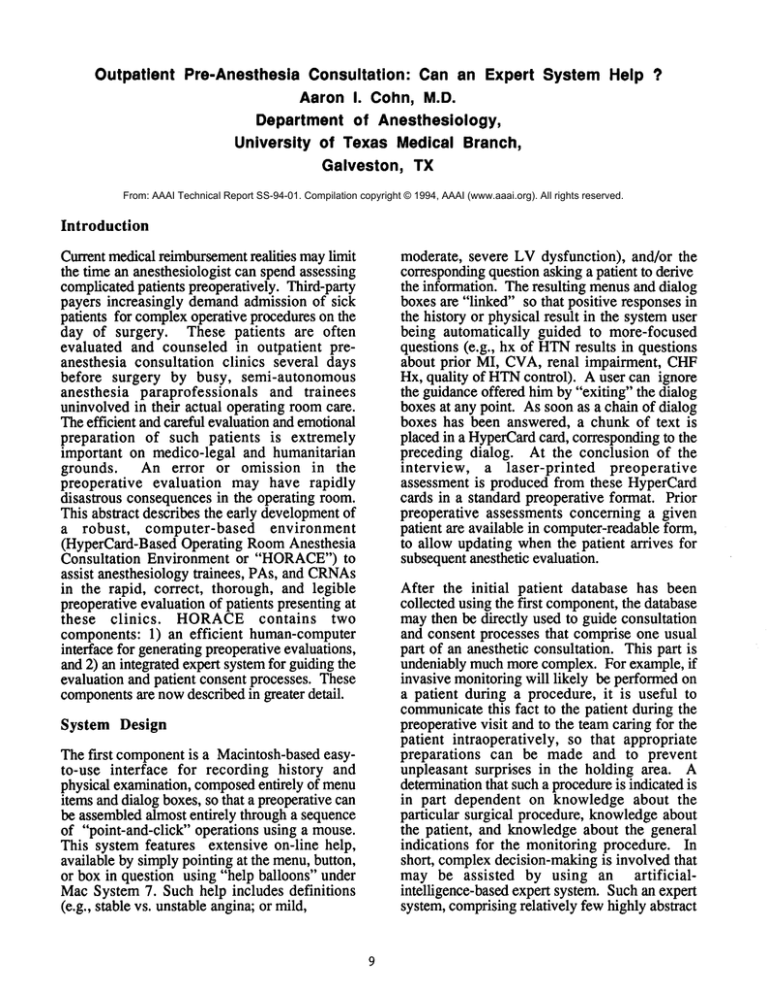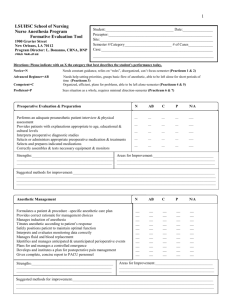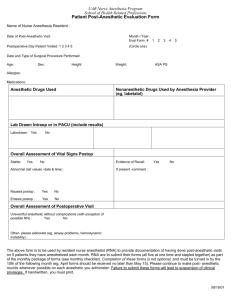
Outpatient
Pre-Anesthesla
Consultation:
Can an Expert System Help ?
Aaron I. Cohn, M.D.
Department of Anesthesiology,
University of Texas Medical Branch,
Galveston,
TX
From: AAAI Technical Report SS-94-01. Compilation copyright © 1994, AAAI (www.aaai.org). All rights reserved.
Introduction
Current medicalreimbursementrealities maylimit
the time an anesthesiologist can spend assessing
complicatedpatients preoperatively. Third-party
payers increasingly demandadmission of sick
patients for complexoperative procedures on the
day of surgery. These patients are often
evaluated and counseled in outpatient preanesthesia consultation clinics several days
before surgery by busy, semi-autonomous
anesthesia paraprofessionals
and trainees
uninvolved in their actual operating roomcare.
Theefficient and careful evaluation and emotional
preparation of such patients is extremely
important on medico-legal and humanitarian
grounds. An error or omission in the
preoperative evaluation may have rapidly
disastrous consequencesin the operating room.
This abstract describes the early developmentof
a robust,
computer-based
environment
(HyperCard-Based Operating RoomAnesthesia
Consultation Environment or "HORACE")to
assist anesthesiology trainees, PAs, and CRNAs
in the rapid, correct, thorough, and legible
preoperative evaluation of patients presenting at
these clinics.
HORACEcontains
two
components: 1) an efficient human-computer
interface for generatingpreoperative evaluations,
and 2) an integrated expert systemfor guiding the
evaluation and patient consent processes. These
componentsare nowdescribed in greater detail.
System Design
The first componentis a Macintosh-basedeasyto-use interface for recording history and
physical examination, composedentirely of menu
items and dialog boxes, so that a preoperative can
be assembledalmost entirely through a sequence
of "point-and-click" operations using a mouse.
This system features extensive on-line help,
available by simply pointing at the menu,button,
or box in question using "help balloons" under
MacSystem 7. Such help includes definitions
(e.g., stable vs. unstable angina; or mild,
moderate, severe LVdysfunction), and/or the
correspondingquestion asking a patient to derive
the information. The resulting menusand dialog
boxes are "linked" so that positive responses in
the history or physical result in the system user
being automatically guided to more-focused
questions (e.g., hx of HTNresults in questions
about prior MI, CVA,renal impairment, CHF
Hx, quality of HTNcontrol). A user can ignore
the guidance offered him by "exiting" the dialog
boxes at any point. As soon as a chain of dialog
boxes has been answered, a chunk of text is
placed in a HyperCardcard, correspondingto the
preceding dialog. At the conclusion of the
interview, a laser-printed
preoperative
assessment is produced from these HyperCard
cards in a standard preoperative format. Prior
preoperative assessments concerning a given
patient are available in computer-readableform,
to allow updating whenthe patient arrives for
subsequentanesthetic evaluation.
After the initial patient database has been
collected using the first component,the database
maythen be directly used to guide consultation
and consent processes that comprise one usual
part of an anesthetic consultation. This part is
undeniably muchmore complex. For example, if
invasive monitoring will likely be performed on
a patient during a procedure, it is useful to
communicatethis fact to the patient during the
preoperative visit and to the team caring for the
patient intraoperatively, so that appropriate
preparations
can be made and to prevent
unpleasant surprises in the holding area. A
determinationthat such a procedureis indicated is
in part dependent on knowledge about the
particular surgical procedure, knowledgeabout
the patient, and knowledge about the general
indications for the monitoring procedure. In
short, complexdecision-making is involved that
may be assisted by using an artificialintelligence-based expert system. Suchan expert
system, comprisingrelatively few highly abstract
decision rules and semantic networks composed
of frame-like objects,
is under active
development as the second component of
HORACE.
This new expert system will be used to guide
patient consent processes for: a) invasive
monitoringintraoperatively; b) awakeintubation,
c) blocks for postoperativepain, d) postoperative
mechanical ventilation, and for preoperative
consultation (specifically including cardiac,
pulmonary, endocrine,
and neurologic
specialties). Thecapacity of an expert system to
explain its "reasoning" maybe utilized to help
educate anesthesia residents using the system.
Further, reports will be generated for the
operating room concerning need for special
procedures and resources e.g., pressure
transducers, difficult intubation carts. These
reports will include the justifications for utilizing
each resource.
monitoring procedures, nerve block procedures
with attributes
such as indications,
complications,contraindications, etc.
c. Anesthetic Modalities KB: GAmodalities,
Regional Anesthesia Modalities, Combined
Modalities, etc. with semantic links into the
Anesthetic Procedures KB.
d. Neuro-Anatomical Correlates KB: a KBto
relate nerve block with anesthesia, e.g., regions
blocked with axillary brachial plexus blockade,
anatomic regions blocked with dermatomal
blockadein epidural, spinal.
e. Medical Conditions KB: Initially a brief,
succinct KB including the most commonly
encountered medical conditions of anesthetic
interest with semantic links into anesthetic
procedures
and modalities
KBs (when
management
will be altered) and indications for
preoperative consultative referral. KBcan be
expandedlater.
Knowledge Representation
The prototype humaninterface, developed using
HyperCard and Windowscript is being further
enhanced. Five knowledge bases (KBs)
composedof frame-like objects and rules for
manipulating them, are under developmentusing
Nexpert-Object (a commercially available
knowledge representation
tool).
These
knowledgebases are as follows:
a. Ooerative Procedures KB: a reasonably allinclusive KBincorporating surgical procedures
performed along with associated attributes
(incision location, operative positioning,
anticipated blood loss, anticipated fluid shift
magnitudes, anticipated procedure length,
anticipatedpostoperativepain).
b. Anesthetic Procedures KB: Hierarchy of
objects such as airway control procedures,
in HORACE
Wewill nowconsider certain specific examples
of object hierarchies and rules from HORACE’s
expert system component. In this section, we
will consider specifically aorto-bifemoral bypass
grafting as an example. This surgical procedure
is sufficiently involved and frequently performed
on sufficiently sick patients to illustrate the
approach being pursued. The following object
hierarchy represents a brief expansionabout the
Aorto_Bifemoral_Bypass
class showing
expansion to include its generalization
(Vascular_Surgery), and its other progeny(slotexpansionsof these progenyare not illustrated):
Figure 1
j~
Annthetlo_Toohnlques
/
IllnltValdUO= Inclllon_l
¯ ’llnlgV,,lue. Sevoro
¯ 11nllVa~lue.Sovero
Decisions regarding invasive monitoring are frequently made preoperatively by anesthesiologists
considering the medical condition of the patient and the relative stresses imposed by the surgery.
Accordingly, knowledgeconcerning prototypical stresses imposedby the surgery is encodedat the class
level. Slots for monitoringand anesthetic techniques are left to be asserted at the instance level. The
followingrule hierarchyillustrates typical decisionmakingfor arterial line placement.
10
Figure 2
<lSurgeryl>.Anestheti¢_Techni~
~r 2
=>Execute’SetMultiValue"(@Al~/"
~~~
<lSurgeryl>’Hem°dynamic-lnst~’~=r
=>Execute
"SetMultiValue"(@
<lSurgeryl>
=>Execute
Blood Loss Is
¯
"SetMultiValue
1 9
A’I
.~/"
--
art line_indicated
-
"M¢~...~
A~r.3
(@AI".~-
Similarly, knowledgeconcerninglikelihood of postoperative ventilation maybe partially encodedusing the
followingrule hierarchy. Alsoshownis a typical rule from this hierarchy
Figures 3 and 4
Name <lSurgeryl>.lncision
\lncision_Types\.Proximate_S
<lSurgeryl>.Pain
<lSurgeryl>.Length
Is
InCrl~~
~ ~-~,r.6
"Severe
Is "Long’,"~
¯
~
poss_postop_vent
r.5
.~
Rule 6
If
<ISurgeryl>.Incision
is assignedto Inclsion_Types
And \Incision_Types\.
Proximate_Structures
is "Diaphragm"
And <ISurgeryl>.Pain
is "Severe"
Then ~i s..pomtop_vent
is confirmed.
Decisionmakingconcerningutility of central neuraxial blockadeinvolves estimates of the pain involved in
a procedure, location of that pain, neuro-anatomicalcorrelates, and specific contraindications to a block.
The following rule provides an example by which such decision making might be madewhen combined
with the anatomicalstructures hierarchy shownin the succeedingfigure.
Figures 5 and 6
Ru/e 4
If
<ISurgezyl>.Paln
is "Severe"
And <ISurgezYl>.Incision
is assignedto Inclsion_Types
And \Incision_Typesk.Start
is assignedto Incisio~_Starts
And \Incision_~l~es\.Stops
is asslgnedto Inclsion_Stops
And \Incisictt.Starts\.Ncsarologic
Correlates
is assignedtO Incision_~euro
Structures
Start
And \Inclsion_Stops\.Neurologic_Correlates
is assignedto Incisicrt_Neuro_Structures_Stop
And \Incision_Neuro_Stzuctures_Start\.Block_Modalities
is "E~idural"
Theft l~idural_Indlc&ted
is confirmed.
AndExecute
¯ SetMultiValue"
(@ATOMID=<
I Surgery
I ¯.Anesthetic_Modalit~/;
QSTRING="
QADD=EpickL--al,
8NODOPLICATE,
t~CCt~P=STRI
NG’;)
ii
The above figures
knowledgebase.
were all drawn directly
from NEXPERT-OBJECT
2.0 B using the HORACE
Current System
Directions
Potential Benefits
Somepotential benefits of HORACE
include: 1)
automated oversight of junior clinicians where
continuous supervision
by an attending
anesthesiologist is not economicallyfeasible; 2)
facilitated
construction of a more legible
assessment by the user interface (potentially
increasing user acceptance of the advice-giving);
3) improved communication of special needs
(e.g., invasive monitoring, special airwaycontrol
techniques) to the operating room.
Status
and Future
The data managementfunctionality of HORACE
has been developed in crude prototype form.
This functionality
has not been described
extensively in this article. The expert system
portion of HORACE
is currently under active
development.The part of the system relevant to
aortic reconstruction has previously been
discussed. As can be seen from this realistic
example, anesthesiologists typically think in
terms of time, space, anatomy, block modalities
and other variables when consulting with a
patient. This is rather involved reasoning. The
pathophysiologic knowledge-base is currently
under supervised development by a senior
medical student during his elective.
The
interfaces
between the data management
functionality and the knowledge-based system
have yet to be developed. Initially
a
unidirectional transfer of information to the
expert system in a seamless fashion will be
performed. Eventually, interesting questions in
intelligent humaninterface developmentmaybe
encountered as more direct interaction of the
expert system with the clinician is developed.
Eventually, the user interface will be used to
direct queries from the expert system component.
HORACEin Context
HORACE
relates to a numberof prior projects in
anesthesia and medicine. ATI’ENDING
(1) was
an expert system whichcritiqued anesthetic plans
developed by junior anesthesiologists.
However, ATTENDING
1) did not emphasize
passive role for the expert system embeddedin a
larger non-AIdevelopmentto encourage clinical
acceptance, and 2) did not involve itself in the
larger issues of intraoperative monitoring,
postoperative
pain, and postoperative
prognostication.
Further, ATTENDING
was
very involved in risk-benefit trade-offs of
different anesthetic approaches. HORACE
is
primarily concerned with prognostication of
procedures that mayreasonably be employedin a
given case. The ultimate choice of procedural
mix will be left to the clinician caring for the
patient. ONCOCIN
(2) was a medical expert
system which rendered advice concerning cancer
chemotherapy planning in a worksheet form
similar to those which clinicians actually use.
ONCOCIN
asked the clinician a question by
unobtrusively placing a question-mark in the
work-sheet where information of interest to the
expert system should be entered. Thus,
ONCOCIN
is similar to HORACE
in the sense
that each has an expert system embeddedwithin
and receives information from non-AI data
management
functions of interest to clinicians.
References:
1) Miller PL. Expert Critiquing Systems:
Practice-Based
Medical Consultation
by
Computer. NewYork: Springer-Verlag.
2) Shortliffe
EH, Hubbard SM. Information
systems for Oncology. In DeVita VT, Hellman
S, Rosenberg SA (eds), Cancer: Principles and
Practice of Oncology. Philadelphia:
J.B.
Lippincott, 1989, pp 2403-2412
12






